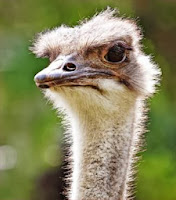Facts about ostriches

- Order The Ostrich belongs to the ratite order Struthioniformes.
- Where found South Africa; East Africa; Sahara and adjacent Sahel region. In dry grasslands.
- Height Male about 8 ft (2.4 m); female about 6 ft (1.8 m).
- Height 140-230 lb (63-l05 kg).
- Feeding They mainly feed on seeds, shrubs, grass, fruit and flowers.
- Lifespan 30-68 years.
- Its scientific name Struthio camelus is derived from Latin, struthio meaning "Ostrich" and camelus meaning "camel", alluding to its dry habitat.
- In South Africa, the adults and the growing chicks band together in larger groups and establish a pecking order. In different localities, ostriches breed at difierent times, but often before the onset of rains so that growing birds will have enough to eat.
- The Ostrich is the world's fastest two-legged animal (43 mph).
- Their long legs enable ostriches to forage over long distances to find food plants amid sparse vegetation. In East Africa, ostriches breed during the dry season. In South Africa, the sexes separate into different flocks ready for the courtship before they disperse into nesting territories.
- In South Africa, breeding begins. A male mates with 3 or 4 females, and in the next 3 weeks each lays 4-8 eggs in one nest (a scrape in the soil) to give a clutch of about 25. The eggs are incubated for 6 weeks by the male and dominant female. About half hatch. Chicks feed themselves at once.
- Chicks are tended by the male and the dominant female; they may try to distract predators such as jackals. They also shade the chicks from the sun, and lead them to food and water. Only about 1 chick in 10 survives to be 1 year old.
- In some countries, people race each other on the back of Ostriches.
